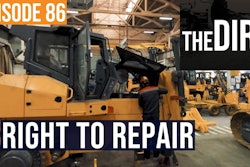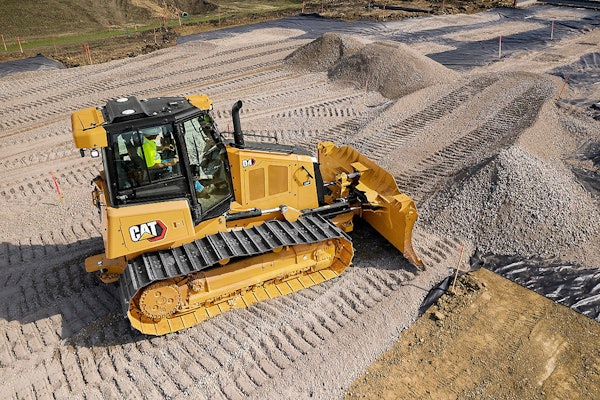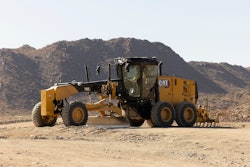In this episode of The Dirt, we hear from Christian Yanes from Steelwrist about the growing popularity of tiltrotators and their benefits.
The devices for excavators add a whole new dimension to digging and other tasks by enabling buckets and other attachments to tilt side to side and rotate 360 degrees. There is a learning curve, but the return on investment can be significant due to being able to do more jobs with one excavator and do those jobs faster and with fewer workers.
So check out this latest episode of The Dirt to learn more about these devices, which can greatly expand efficiency and speed on the job.
Equipment World serves up weekly videos on the latest in construction equipment, work trucks and pickup trucks – everything contractors need to get their work done. Subscribe and visit us at equipmentworld.com!
In this episode:
00:00 Tiltrotators
03:04 The efficiency of tiltrotators
06:53 Changing the way you think about excavators
09:37 The excavator is no longer an excavator
13:09 Control system and installation
15:15 Steelwrist configurations
20:11 Wrap up on tiltrotators
Bryan Furnace (00:09):
Hi everyone. Welcome back to Equipment World. You're watching The Dirt. I'm your host, Bryan, and today we're going to talk about tiltrotators, those super popular attachments over there in Europe that are slowly starting to trickle their way into our market here in America. Today we're talking with Christian Yanes from Steelwrist. Who's going to walk us through just how a tiltrotator can totally change your business.
The first thing, we're just going to fire this whole thing off with the typical American response when you talk about any sort of tiltrotator is, "I can buy a mini excavator for that. What do I need one of those for?" What's your response to this reaction?
Christian Yanes (00:46):
I try to be as polite as possible, first of all, to that kind of approach. The tiltrotator mentally is not for everybody out there. We see that the people who are starting to use it predominantly are the ones who are already working with other kinds of technology, be it machine control system. It's the same there. You can buy a mini excavator for what you can pay for a system, like a machine control system, a Dig Assist, you name it, 3D system. So those customers that aren't ready for this kind of technology, we let them know what are the benefits and what are the disadvantages. But eventually they will figure it out. That's my belief. Eventually they'll figure it out, once other people have proven to them that they can do the jobs much faster, more efficiently, with this kind of technology versus having a mini excavator beside the big excavator standing still.
I think the customer that is looking for this kind of technology is already looking at cost savings more than... I try to explain, "This as an investment, you can't see it as a cost. You've got to see it as an investment because you'll be able to do more jobs with one machine. You'll be able to do the same jobs faster, with that same machine and you'll be able to do that job with less labor, meaning that you'll be able to eventually get a return on the investment and be making money out of it." We sell predominantly today in the northeast and the northwest, which typically have higher labor cost, so it makes more sense because you get the return on investment much sooner. So that's the pitch on explaining to them that it's not a cost, it's an investment that you're looking at.
Bryan (02:20):
Just to reaffirm what you just said, my experience with a tiltrotator, for the three days was utter misery. It was going back to running an excavator for the first time for me just because you have no idea what all of these new buttons do and as a result, for a little while your labor actually goes up because you're like, "Ah, just take care of it with the shovel." But once you get through that initial training phase, far less labor. I was able to get in so tight to anything I was grading, that if you had any shovel work, it was a quick once over with a rake and you were done. It wasn't like a traditional excavator where, "Oh, we're working on this funky slope, so you're going to have to hand tune all that in while I move forward another 20 feet and start working the next area."
Christian Yanes (03:06):
It can potentially become a one-man show where you have one operator and one machine with a tiltrotator that will do the job, which once again, looking at the efficiency, you don't need to get rid of that labor, but you can put that labor somewhere else where they can be of benefit versus just standing holding a shovel looking at the machine work. So we normally say that the learning curve is a two-week period for a professional operator who's used to running machines. For some people it's much shorter. I've seen the younger generations that are used to the PlayStation and different consoles, that get on the machine and you wonder, "Have you been on a tail rotator before?" And when they get out of the machine they say, "No." Then you can see that their brain is already wired to multitask. Older generations, they get there as well, but it's a longer period, and normally I say two weeks of frustration and then after those two weeks the sky's the limit and you come to a point where they can not dig without one.
It's interesting how that happens, from not being able to operate it to not being able to dig without one or being frustrated of not having one. But what I tend to say, if you're in a position where you find overwhelmed by all the buttons and all the rollers, just make sure that the bucket is facing your machine like you've always had it and then...
Bryan (04:14):
Back to a regular excavator.
Christian Yanes (04:15):
...like you always have done... Exactly. But then you see yourself, in no time pressing those rollers to get that bucket to tilt or rotate to help you get to where you really want to get.
Bryan (04:24):
Are you finding that younger generations tend to adopt the tiltrotators quicker than the older generations?
Christian Yanes (04:31):
When it comes to operating and using the machines, I would say, yes, but we got to remember that normally it's the older generation that is in charge of the money and the checks and what gets bought. So we do see a change in when there is a generational change in companies, where the kids are starting to run the business but the parents are still involved. There we can see normally it is the kids pushing because they are the ones who are most commonly on Instagram and YouTube and social media, where a lot of footage is being exposed to them. So then we see that the push comes from them. But not only. I wouldn't say it's only them. We have a lot of customers of older age that are brilliant at this, not only in North America but in other countries as well.
Bryan (05:15):
So you briefly touched on it with the hand work, but what are some of the other ways that a tiltrotator can really change the way a company operates and thinks about that machine?
Christian Yanes (05:25):
I would say predominantly every job that you put the machine on, will increase in efficiency whilst having a tiltrotator on. Of course, I sell the product so it sounds a little biased, but I have seen it and I get those comments from customers that have taken the step and moved forward to actually buying one and starting to use one, "I will never go back to working without one." Or I get calls from customers actually saying to me, "Today I saved 400 bucks and just being able to unload that truck in five minutes on my own versus having somebody jump on the back of the bed and deal with ropes and so on." So it's gratifying to be selling the product in North America, because in Sweden or in Northern Europe in Scandinavia where this is a must where every machine has one, then the customers just buy one and they use it and that's it.
But here, given that it's new, it's really fun to hear the feedback from customers that are like, "Why didn't we have this 10 years ago? Why did we wait so long in investing in a product that has made life so much easier for us?" I think even operating becomes much more fun because there's another dimension to it. Of course, it's difficult to sell because it's a new product. I think a lot of people are still waiting, "Let's somebody else try it and if it goes well for them, we'll invest." But all that trying and testing has already happened in a different continent for the last 30 years. So it's actually being a little shy.
Bryan (06:53):
So I will say, to touch back on changing the way you think, first of all, again, the first time I got my hands on a tiltrotator, after the initial frustration, what you said was 100% true. It was like being a new kid in a piece of equipment again. I've run excavators thousands of times, but that was the first time I got in an excavator that could flip the bucket around backwards and angle it over to the side or it had a little pincher on the back that I could use to lift stuff up. And along those lines, that's where I really noticed the way it changed how I thought about the job entirely.
As an American operator especially, you're used to an excavator being a grading machine and so you think about it one dimensionally as a grading machine, but there's also fork attachments that you can throw on this thing and now all of a sudden you can, in a very tight yard where even a skid steer might be a challenge to unload a truck, you're suddenly able to fork into things and spin them around and manipulate them in ways that you can't do with other machines.
Reaching into the back of a truck to pull out your plate compactor and having the little gripper on the back that's delicate enough that you can very carefully grab metal handles of your equipment. Now you saved a laborer climbing up in the truck and jumping out of the truck. It was just so many small things that totally... It took me a week or two to really do it, but mentally I totally changed the way I thought about that machine functioning for me. It was really interesting how it caused me to totally retool my brain.
Christian Yanes (09:37):
You come with a very good point. We see it as, the excavator is no longer an excavator. The excavator is a tool bearer. Even though the products originally from Sweden, call it the Swiss Army Knife, where it will do a lot of different functions. Pallet fork is a great example, where in some instances, contractors are moving a skid steer or a loader to a job site just because they know that they're going to receive a load that they need to unload. Now if you can unload that load with the excavator, you don't even need to bring that machine to this job site. This machine could be on another job site performing and being efficient versus having a machine that's standing still there for several hours just waiting for that truck that's going to unload curb or blocks or whatever it might be. So you can now do that with the excavator.
With the gripper itself, you can start laying out the curb and then go back to the grading bucket and keep working. So it's not just the pallet forks. We have asphalt cutter, we have brooms, we have sweepers, we have grippers, digging, trench buckets, sorting buckets. I mean the list is endless, and if there is an attachment that we don't provide, we do have the bracket that will weld onto that attachment. So you can always have an attachment that you might have in your yard that you want to use in combination with the Steelwrist and you can weld that the same size bracket that the tiltrotator has and adapt that tool to the tiltrotator. So the sky's the limit, really.
Bryan (11:02):
This is why I need more time with tiltrotator. I haven't even begun to unlock the possibilities here. I do have to ask, Steelwrist is not the only tiltrotator out on the market. What are some of the things that really sets Steelwrist apart from the competitors?
Christian Yanes (11:19):
Well, what we have, we came in later on to the game, so we came in as an underdog, where some of the other manufacturers had been in the industry for quite some time. So it became very obvious for us, that at the beginning we needed to come with something different. We can't just offer the same thing for the same price and hope to make it because people are brand loyal to different products. So what would get somebody to switch from whatever product they were using to Steelwrist? So we positioned ourself in an innovator position, where we started bringing in new things to the industry. We were the first ones to come in with 45 degree angle, giving a little bit more tilt. Five degrees doesn't sound like much, but when you have your bucket full of material and you're rotating, those five degrees are going to help you keep a lot of material in the bucket.
We were the first ones to come with a steel-casted solution and that's of course, we're adding a lot of weight at the end of the stick, we don't want the machine to be unstable or hoppy. So then by casting in steel we were able to make a stronger product and then at the same time reduce the weight of it. Something which is very important that maybe the potential buyer doesn't know is the building height. How much are we prolonging the height of the distance between the pin on the stick and the bucket pin? The more you're prolonging that stick, the weaker the machine's going to be, the less breakout force you have. So we were able to do this with a more compact solution, so that the machine wouldn't lose as much power, so to say, when using it. So there is a lot of... Sure, all tiltrotator manufacturers, they tilt and they rotate. Most of them come with a gripper, some call it, some people call it the grab or the pincher. That is optional.
But when looking at the product technically there is a lot of other features and patents and so on, that the tiltrotator companies offer to differentiate themselves from each other. We have, I would say, a very good control system and I think we'll touch that soon, where it's not just hooking two lines and the tiltrotators operating, we're actually installing a computer in the machine and making sure that it communicates correctly with the excavator so that the precision on all the functions is, as you mentioned earlier, when using the gripper, proportional and very precise. So we have a very good advantage towards our competition as well with our control system, where our joystick, I think the L8 joystick is probably the most demanded tiltrotator joystick out there today.
Bryan (13:40):
Interesting. So we're not just putting joysticks with buttons into the machine when we install one of these tiltrotators. You actually have an interface that is working in tandem with the machine
Christian Yanes (13:53):
Of course. Back in the days when it started, you just send an installation kit to a mechanic out there at the dealer and they put it together and it was a little bit of a one-size-fit-all installation kit. But with time, machines have developed and machines are [inaudible 00:14:09] communication, some are not. So we can no longer do a one-size-fit-all. I'll give you a great example, the Cat 305 has an installation kit that is made for that machine. But if it's an NextGen machine, that same installation kit will not work because now we got to communicate with the Cat machine, making sure that there's no error codes that are bopping up or making sure that the communication is correct, because we are replacing original joystick and putting our own. So of course the machine today, they're very intelligent, they say, "Hey there's a problem here, my joysticks missing."
How can we make sure that we can replicate the signals that the Cat joystick or the Volvo joystick, or whichever brand it is because machines are becoming more and more advanced, without letting those error codes appear. We also have the integration to machine control system, where our control system needs to communicate with the machine control system. And I'll clarify when saying machine control system. It could be Trimble, Topcon, Leica, MOBA, iDig, Hemisphere. There's a lot of systems out there and more coming. So there's an integration as well, between our system and their system so that when we rotate our bucket, we're giving them the signal and the positioning of where is our bucket located in relation to the ground. So there is a lot more technology than the eye can see, I would say.
Bryan (15:30):
That is far more... Because I was very much under the impression that this was, "Okay, here's your two new joysticks, that's got three extra functions on them. Plug them in, go." And I had no idea, but it does make sense, especially like you said, with the grade control that's now coming a lot of times standard from the factory, that they are going to need that information. I hadn't even thought about that component.
Christian Yanes (15:54):
So you have that option and I tend to say the tiltrotator is a configured product. Imagine that you're going to go buy a new vehicle and you go into the website of the manufacturer and you start choosing the rims and you start choosing the color and do you want that option or this option, but I don't want that one. And at the end you have a configured product. The till rotator is pretty much the same. A lot of people see it as a clump of steel that's hanging at the end of the excavator.
But the gripper for example that we were talking about earlier, the pincher or the grabber, is an option. We have the option of mounting the tiltrotator directly at the end of the stick and then the tiltrotator is always installed on the machine or we have the option, as what we call it, a sandwich, where we put a quick coupler at the end of the stick that picks up the Steelwrist and then the Steelwrist in itself has a quick coupler allowing you to disconnect the Steelwrist, put it to the side and go straight onto your attachments.
On the control system side, we have track steering. So if you want your machine to move back and forward without using your pedals, we can put that function on the rollers on the joysticks. If we want to do that with a wheel excavator, which is very popular in Europe where the wheel excavators are more predominant than they are here in North America, now we can steer the wheels on the machine, on the roller, without having to let go of the joystick to grab the steering wheel, which of course, once again increases efficiency because the operator's hands are always on the joystick. We can do the same thing with a blade, depending on the machine. Let's call it blade control, where we can pull up and pull down the blade with the roller versus having to let go of the joystick to pull on the lever. There's a lot of options that we can put into the package so to say, that will affect the price of the setup.
Bryan (17:28):
This is fascinating and way more in depth than I ever thought these attachments were. This is awesome. So that leads us into my last question for you, which is really, what's involved with the installation of a Steelwrist tiltrotator? Is this something where I am dedicating a machine, it's only going to have a Steelwrist on it, I can't go pull concrete anymore? Or do you still have some versatility with the machine?
Christian Yanes (17:51):
Well the common question when talking to somebody who is, let's say knowledgeable in the area and trying to advise you on, the first question is, what are you intending to do with this excavator? Given I just explained the setup of having a couple in between or no couple, that's going to affect the potential of the possibilities of what attachments you can put on and what you should do or shouldn't do. For example, I normally tend to recommend the sandwich, where you have a quick coupler first and then the tiltrotator, because if at any point you need the machine's maximum breakout force or maximum lifting capacity, you can easily remove the Steelwrist, put it to the side and go straight onto your attachments, like a conventional machine. Call it a pin on bucket with a quick coupler. Let's say that have a bigger machine, a larger machine, and that for the next two weeks, the only thing you're going to be doing is loading trucks, you don't need the extra weight of the tiltrotator if the only thing you're going to do is this.
So improve your cycle time, have a bigger bucket, don't wear out the product with no use. So then you would sandwich, take away the tiltrotator, put it to the side and go on a bigger bucket. But then as soon as you need that finesse and you're going to do those cleanup jobs or it's tied and you can't really reach, then you just put the Steelwrist back on. So I wouldn't say that once you have a Steelwrist, limiting yourself to some jobs, because you have the option of being able to take it off.
Now Bryan, to take you to the next level of complexity, there is different systems out there. In our world we call it the SQ. Other manufacturers have their own name for it and what that entitles, is that at the same time as I'm connecting the tool, the hydraulics for that tool are also connecting. So I'll give you the example. I can drop the tiltrotator without leaving the cab and I can pick up a hydraulic breaker and use the breaker for 10 minutes, drop the breaker, go back to the tiltrotator and the bucket without leaving the cab.
That's another configuration that we can add to the tiltrotator would be the SQ technology. But if you're a contractor that said, "Well I don't have any hydraulic tools, I just have a dig bucket and a grade bucket," then I wouldn't promote the SQ. I'd say, "Well, you go with a standard S," is what we call it, "and then if you did want to connect a grapple or any hydraulic tool, you would have to get out of the cab and connect them manually to hoses to get them to run." So like I say, the options are endless.
Bryan (20:11):
The reason I sit here just in silence for a moment is because I think about the efficiency, the versatility and all of these benefits. And yet at the same time, in the other side of my brain, I can hear all of the American, "That'll never work, that'll never work, that'll never work." And it makes me laugh because it's one of these things that it just takes going out there, putting your head down for two weeks and getting through that learning period and I can fully attest, because I've ran a tiltrotator before. It totally changes the way you think about using that machine. And just the two parts of that conversation, they just crack me up at the moment because we are really... It's almost like the American market is slowly coming into the present after being stuck in the past of 20 years ago and they are kicking and screaming the whole way there. But it's incredible seeing these attachments finally take off.
Christian Yanes (21:10):
I can easily say with all confidence, whether I worked for Steelwrist or if I go work somewhere else, the tiltrotator concept is coming whether we want it or not. Whether it's a Steelwrist or another brand, the tiltrotator as a product and as the new way of operating, is coming faster than a lot of people think, whether you like it or not. And if we were to look back several years from now, we'll laugh at this conversation we're having now because it'll be so obvious in a few years, that so many people have a tiltrotator. So the tiltrotator concept is coming whether you like it or not. And I would say the sooner you get on board with it, the more advantage you have to your competitors and competition that are blinded and not even paying attention at the new technologies that are coming.
Bryan (22:03):
Well thank you again for Christian taking time out of his day to come on the show and talk to us about tiltrotators. I will say I have run a tiltrotator and once I got through that trial period, it was unbelievable what you could do with those machines. I absolutely cannot attest enough as to how much tiltrotators will change your business. So as always, thank you for watching. I hope this has been helpful and we'll catch you guys on the next episode of The Dirt.









